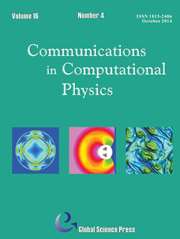Crossref Citations
This article has been cited by the following publications. This list is generated based on data provided by
Crossref.
Liu, Na
Cai, Guoxiong
Zhu, Chunhui
Tang, Yifa
and
Liu, Qing Huo
2015.
The Mixed Spectral-Element Method for Anisotropic, Lossy, and Open Waveguides.
IEEE Transactions on Microwave Theory and Techniques,
Vol. 63,
Issue. 10,
p.
3094.
Shi, Linlin
Liu, Na
Zhou, Jianyang
Zhou, Yuanguo
Wang, Jiamin
and
Liu, Qing Huo
2016.
Spectral element method for band-structure calculations of 3D phononic crystals.
Journal of Physics D: Applied Physics,
Vol. 49,
Issue. 45,
p.
455102.
Shi, Linlin
Zhou, Yuanguo
Wang, Jia-Min
Zhuang, Mingwei
Liu, Na
and
Liu, Qing Huo
2016.
Spectral element method for elastic and acoustic waves in frequency domain.
Journal of Computational Physics,
Vol. 327,
Issue. ,
p.
19.
Zhou, Yuanguo
Shi, Linlin
Liu, Na
Zhu, Chunhui
Liu, Hai
and
Liu, Qing Huo
2016.
Spectral Element Method and Domain Decomposition for Low-Frequency Subsurface EM Simulation.
IEEE Geoscience and Remote Sensing Letters,
Vol. 13,
Issue. 4,
p.
550.
Liu, Na
Cai, Guoxiong
Zhu, Chunhui
Huang, Yueqin
and
Liu, Qing Huo
2016.
The Mixed Finite-Element Method With Mass Lumping for Computing Optical Waveguide Modes.
IEEE Journal of Selected Topics in Quantum Electronics,
Vol. 22,
Issue. 2,
p.
187.
Liu, Jie
Jiang, Wei
Lin, Fubiao
Liu, Na
and
Liu, Qing Huo
2017.
A Two-Grid Vector Discretization Scheme for the Resonant Cavity Problem With Anisotropic Media.
IEEE Transactions on Microwave Theory and Techniques,
Vol. 65,
Issue. 8,
p.
2719.
Chen, Ke
Hou, Xuanying
Zhuang, Mingwei
Liu, Na
and
Liu, Qing Huo
2019.
An Efficient Mixed Finite-Element Time-Domain Method for Complex Electrically Small Problems.
IEEE Transactions on Microwave Theory and Techniques,
Vol. 67,
Issue. 4,
p.
1285.
Chen, Ke
Liu, Jie
Zhuang, Mingwei
Sun, Qingtao
and
Liu, Qing Huo
2020.
New Mixed SETD and FETD Methods to Overcome the Low-Frequency Breakdown Problems by Tree-Cotree Splitting.
IEEE Transactions on Microwave Theory and Techniques,
Vol. 68,
Issue. 8,
p.
3219.
Shi, Linlin
Zhuang, Mingwei
Zhou, Yuanguo
Liu, Na
and
Liu, Qinghuo
2021.
Domain decomposition based on the spectral element method for frequency-domain computational elastodynamics.
Science China Earth Sciences,
Vol. 64,
Issue. 3,
p.
388.
Guan, Zhen
Liu, Jie
Zhuang, Mingwei
and
Liu, Qing Huo
2021.
A Hybrid SESI Method for Electromagnetic Scattering by Objects in Multiregion Cylindrically Layered Media.
IEEE Transactions on Microwave Theory and Techniques,
Vol. 69,
Issue. 9,
p.
3967.
Liu, Qi Qiang
Zhuang, Mingwei
Zhan, Weichen
Shi, Linlin
and
Liu, Qing Huo
2023.
A hybrid implicit-explicit discontinuous Galerkin spectral element time domain (DG-SETD) method for computational elastodynamics.
Geophysical Journal International,
Vol. 234,
Issue. 3,
p.
1855.
Jiang, Jiantao
and
An, Jing
2023.
Numerical approximation based on a decoupled dimensionality reduction scheme for Maxwell eigenvalue problem.
Mathematical Methods in the Applied Sciences,
Vol. 46,
Issue. 16,
p.
17367.
Wang, Wei
Zheng, Jihui
and
Han, Jiayu
2024.
An Effective Finite Element Method for Maxwell Eigenvalue Problem in a Radial Inhomogeneous Medium.
p.
1.
Jiang, Jiantao
and
Zhang, Zhimin
2024.
An efficient decoupled and dimension reduction scheme for quad-curl eigenvalue problem in balls and spherical shells.
Computers & Mathematics with Applications,
Vol. 174,
Issue. ,
p.
454.
Liu, Kai
Tang, Ming
Xing, Xiaoqing
and
Zhong, Liuqiang
2024.
Convergence of adaptive mixed interior penalty discontinuous Galerkin methods for H(curl)-elliptic problems.
Computers & Mathematics with Applications,
Vol. 170,
Issue. ,
p.
84.
Tang, Ming
Xing, Xiaoqing
and
Zhong, Liuqiang
2024.
A posteriori error estimator for mixed interior penalty discontinuous Galerkin finite element method for the H(curl)-elliptic problems.
Journal of Computational and Applied Mathematics,
Vol. 436,
Issue. ,
p.
115407.

